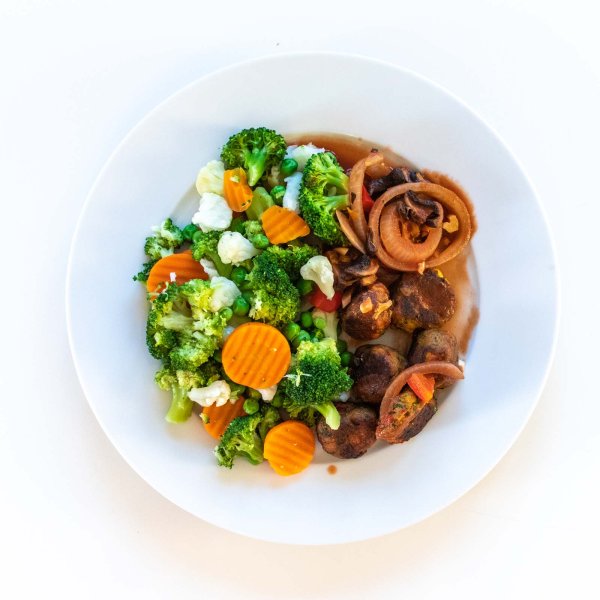JUMP TO
Drinking from plastic bottles will do more harm than good for your health. Do you think it’s time to change to a reusable water bottle? In this article, we discuss what options you have and how to choose the best reusable water bottle.
Whatever you’re on the road, at the office, in the gym or at home, chances are that at some point you’ll be drinking water. And chances are that you don’t carry a water glass with you, instead you’ll probably be drinking from a plastic bottle. There’s no shame in it, I did it for many years until I realized that plastics aren’t that great for my health.
We enjoy drinking from bottles because they’re easy to carry around, they can hold a bigger quantity compared to a glass, they’re spill resistant and very easy to use on the go. I get all that! Unfortunately, most of the bottles around us are made of plastic (and almost always the plastic used is of the cheapest quality) and that’s not good for us or for the environment.
That’s why I decided to put together this article, in an attempt to explain why it’s important to use a non-plastic bottle and what alternatives are out there. I’ve also tried to come up with practical solutions for choosing your next water bottle so please stay with me until the end and I promise you’ll find some useful info inside this article.
Here are the main topics that we’ll be discussing:
- Why do you need a new water bottle?
- Why is it important to use a non-plastic bottle?
- What are the alternatives to plastic bottles? Pros and cons?
- What are my choices and why?
What’s The Deal With Plastics?
Since the plastics industry has developed in the 1950-1960s, plastics have slowly replaced ceramics and stainless steel in our daily lives. And when it comes to eating, drinking or preparing your food, plastic is one of the worst choices you can make. Let me rephrase this: plastic is the worst choice you could make! At the same time, our kitchens are loaded with items made from plastics, plus we already use too many plastics than we need to.
Here are a few of the major disadvantages of plastics:
- Plastics are made using endocrine disrupting chemicals (BPA is the most known, followed by Phthalates and others).
- Plastics are reactive to the following factors: heat, oil, acidity, abrasion, and time.
- Because they react with the factors above, they pass chemicals into our foods and our bodies.
- Let me rephrase this: when plastics come in contact with heat, oil, acidic foods or if they’re scratched, they will release endocrine disrupting chemicals. That’s not good for our health since these chemicals will interfere with our body’s endocrine system, thus leading to many of the chronic health conditions we see in our society today.
- Many of the plastics aren’t reusable and, even if they are reusable, it’s likely that in a matter of weeks they’ll become damaged and will need replacement.
- Plastics are also made with chemicals that aren’t disclosed by the plastics industry (due to industrial secrets) – plastics can be made with a bunch of chemicals we know nothing about.
- Plastics are impossible to clean correctly after a few uses.
- There are 7 general types of plastics (noted Plastics #1 – #7).
- Plastic bottles are made of 2 types of plastics: #1 – PET (bottled water bottles) or #7 (so-called reusable water bottles).
- PET is designed to be used once and thrown away afterwards, not that great for the environment.
- Recycling plastics doesn’t solve the problem of plastic pollution because very few types of plastics actually get recycled.
As we have learned in this section, plastics are one of the worst choices you can make when it comes to food or drinks. Water should always be pure and fresh, and a joy to drink. Drinking from plastic bottles can be ok if you don’t have a choice but, if you want the absolute best, definitely look for healthier alternatives.
Alternatives To Plastic Water Bottles
When it comes to water bottles, there are 2 materials that come up in my mind. Both of them are safe for the environment and healthy for your body:
- Glass
- Stainless Steel
Glass bottles
Advantages of Glass
- glass doesn’t leak any chemicals into the water when exposed to sun or heat.
- glass is reusable for life.
- doesn’t pollute the planet.
- is non-reactive to acidic beverages.
- is cheap to produce and to buy.
- is the safest material you could use for your health.
- glass bottles look great with a silicone cover (fashionable items).
Disadvantages of Glass
- has more weight compared to plastics.
- very easy to break.
- they can’t sustain hot beverages (neither do plastics).
- fashionable glass bottles can be a bit pricey compared to plastic bottles.
Stainless steel bottles
Advantages of Stainless Steel
- impossible to break.
- can sustain acidic beverages and foods (up to a certain acidity).
- are lightweight compared to glass.
Disadvantages of Stainless Steel
- in my opinion, these aren’t as nice when compared to glass water bottles.
- a bit pricey, but remember this is a reusable bottle.
- hard to identify the actual stainless steel formula used by the manufacturer.
What Works For Me
I prefer to carry around a heavier water bottle than to use a plastic bottle. I also like the feeling of drinking from a heavier bottle, a bottle that will keep my water fresh at any temperature or environment. As we’ve discussed before, plastic is not safe for your health, plus reusable water bottles are available everywhere these days so why bother with plastic, anyway?!
As for which type of material I prefer, I definitely like glass bottles vs. the stainless steel bottles.
Why do I use a glass water bottle?
- The short answer is: it’s the healthiest way to drink water.
- I simply like glass as a material – it’s simple, it’s clean and stylish at the same time.
- I like that it’s transparent and I can see the contents inside.
- I don’t mind drinking from a heavier bottle.
- Glass it’s 100% non-reactive when it comes to using acidic drinks (lemon water anyone?). Stainless steel will always react with acidic content, releasing a metallic-like taste.
- Glass it’s still safer compared to stainless steel – glass used for water bottles is of the most basic type (soda-lime), whereas the exact stainless steel formula can differ greatly from one manufacturer to another.
- Glass bottles are still very affordable and can be easily replaced. Plus, they’re easy to find in various local shops.
- You don’t have to buy a fashionable bottle, you can just reuse one of those glass water bottles with ones of those metallic cap. You can find them in any supermarket in the drinks section.
- You can even buy designer’s items, fashionable, trendy water bottles like bkr or Casall (more on this below).
Yes, there’s a risk to break your glass bottle but considering that I broke down only one bottle in 3 years, I’d say this is the exception and not the rule. Plus, keep in mind that all glass bottles come with a nice protective silicone sleeve, which makes it harder to break the bottle.
I’m also choosing to have a glass water bottle because of costs: I don’t like paying for bottled water in shops, I live in Norway and my home water is far better than any bottled water, plus it comes free of charge.
Things To Consider Before Buying a Water Bottle
I bought my first glass water bottle 3 years ago, and I never looked back. As odd as it may seem, there are quite a few things you can take into consideration when buying a new water bottle, especially if it’s the first one you buy.
Quantity – 500 ml, 600ml or 1000 ml – You need to know how much water you want to carry around with you (maybe based on how often you have access to refill with pure water). I discovered that 1000 ml can be a little too much for me, and the bottle was looking ridiculously big. Right now I own a bottle that holds 600 ml which seems to be a good tradeoff for me, between quantity and portability.
Bottle Cap – caps are made from plastic (usually BPA free) and have a silicone gasket inside to prevent spillage. The gasket can be easily removed for cleaning and goes in the same way.
Design – A water bottle makes a statement. I want my water bottle to look good and blend with my style. Nowadays glass water bottles come with silicone sleeves, which add both protection and style to a simple bottle.
Type of Glass – There are 2 types of glass used in the production of glass kitchenware: soda lime glass (common glass) and borosilicate glass (heat resistant). As far as I know, all glass water bottles that I came upon are made from soda lime glass. The soda lime glass is cheaper to produce but it doesn’t support too much heat compared to borosilicate glass. On the other hand, borosilicate glass (which is your Pyrex glass – heat resistant), is more expensive but it’s also heat resistant.
Silicone Sleeve – The sleeve adds to the whole “fashionable” story, making your bottle stand out from the crowd. It’s very easy to remove and clean, so no need to worry about it.
Practicality – A water bottle has to be easy to carry around all day long, and that’s where the attached handle comes in. The handle can be either fixed (bkr) or rather loose (Casall). Either way, make sure your bottle has this item otherwise it will be very hard to carry it around for hours.
Weight – The bigger the quantity, the heavier your bottle will be. As I was saying, my 1000 ml water bottle was both heavy and huge.
Drinking Opening – Some bottles have a normal bottle opening (small) while others have a wider opening. This could be an issue if you lose your bottle cap and you need a temporary one. On the positive side, I discovered that for me it’s easier to drink from a bottle with a wider opening, but this definitely isn’t a deal breaker.
Universal Cap – In case of losing your bottle cap, the wider caps are impossible to find on other types of bottles. If you own a bottle with a normal bottle cap, you can just take a cap from any “normal” water bottle and you’ll be fine until you find the original replacement cap.
Cleaning – The wider the bottle opening, the easier it will be to clean it. Remember that all glass bottles will have to be clean with plain water and soap every 1-2 weeks. Removing the silicone sleeve is easy enough and cleaning it goes smooth as well. I haven’t run into any special problems here so no need to worry.
Warranty – Some companies even offer a 90 days warranty in case you break your bottle. It’s worth asking for a warranty when you buy your bottle.
Customer Support – You will probably need to replace the plastic cap after a few months and that’s where support gets very important. Companies like bkr and Casall know how to communicate and also sell spare parts (caps, sleeves, bottles). Even through Casall doesn’t sell spare caps, they offered to send me one by regular mail. On the other hand, bkr sells replacement caps and bottles so keep this in mind.
Bonus Tips
- Please don’t buy those cheap glass bottles that you can find in the supermarkets. These are usually made from very thin glass, have a poorly designed bottle cap, and they don’t even come with a silicone sleeve.
- Look for a silicone sleeve and not a neoprene sleeve; that’s a clear sign of quality.
- Pay special attention to how solid is the bottle cap and the holding strap. A solid bottle cap has to be a bit bigger and made from thick plastic; also it has to have a solid strap attached to it.
- Look for any info regarding materials – a reputable company will disclose the type of glass used, if the plastic components are BPA free (or other chemicals), plus it’ll always make the sleeve from silicone. Red flags are companies that don’t have a website, brand names you can’t pronounce or can’t be traced on the internet.
- Your bottle will get dirty and will need cleaning from time to time. Just use normal dish soap, rinse thoroughly a few times, and leave your bottle and sleeve to dry naturally before using again.
- The bottle sleeve will also need cleaning, and you’ll have to remove it from the bottle before this operation can take place. Check-out your brand’s website for details on how to remove the sleeve safely without breaking it or the bottle. Being made from silicone, the sleeve is easy to clean with normal soap and warm water. Leave to dry completely before putting it back on the bottle.

My favorite glass water bottles - Casall (left) vs bkr (right)
These Are My Favorite Water Bottles
bkr Water Bottle
- made and sold by a US company, marketed as “fashionable water bottles”.
- their bottles come in various quantities: 250, 500 and 1000 ml.
- the bottle opening is small, like you would have it in any common bottle.
- price starts around 25-30 USD for the smallest bottle.
- I like their color combinations and design styles.
- having a solid strap attached to the cap makes it very easy to carry the bottle around.
- the cap will firmly close and is definitely leak proof.
- the sleeve is made from thick silicone.
- the cap is made from solid BPA free plastic and has a silicone gasket on the inside.
- they sell replacement parts, which is always nice – this includes caps, sleeves and bottles.
- bkr offers a 90 days warranty on any bottle.
- you can buy bkr bottles almost everywhere and past collections are always on sale.
Casall Water Bottle
- Casall is a Swedish sportswear company; water bottles are just one small part of what they do.
- they offer glass and stainless steel variations.
- their glass bottles only come in one size/quantity: 600 ml.
- their stainless steel bottle comes in one size, 500 ml.
- they bottles are taller and not that wide like those sold by bkr.
- the glass bottle opening is bigger compared to what bkr offers (impossible to find spare caps anywhere else).
- they don’t sell replacement caps as replacement parts.
- their bottles come in only a few colors, but this doesn’t make it a deal breaker for me.
- prices are around 20-30 USD.
- they don’t offer any warranty in case of breaking your bottle.
Conclusions
Plastics are a danger to our health and the surrounding environment. Fortunately, today we can choose from a variety of glass or stainless steel water bottles that aren’t only a healthier alternative, they also look and feel amazing.
During the last 3 years, I’ve owned quite a few different water bottles (big or small). My current choice for a portable water bottle is a 600 ml bottle made by Casall, the Swedish company I was telling you above. I like the simple design, the portability and not to mention their customer support.
If you haven’t done it already, please consider making the switch from using plastic to either glass or stainless steel water bottle. You deserve the best, and using a reusable water bottle is the absolute best when you come to clean water. I really think it’s sad that plastics have made such a bit step into our lives, and I believe it’s our responsibility to reverse this path. The convenience of plastics isn’t worth the negative health and environmental impact they bring.
Thanks for reading so far and I hope you’ve found this article useful. Are you already using a dedicated water bottle? If not, I’m curious if this article convinced you to buy a reusable water bottle?



















